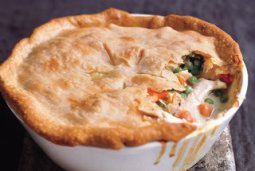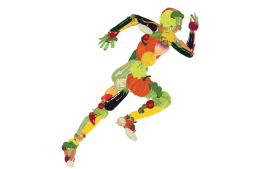Written by Jackie Stevenson, BS, DTR
SAD stands for Seasonal Affective Disorder, often referred to as the “winter blues”. If you are affected by this disorder you know that it doesn’t always wait until winter to set in, but usually coincides with the drastic decrease in sunlight that fall brings. The theory is that the body’s natural circadian rhythms (what prompts sleeping and waking) are thrown off by changes in light. Sunlight itself plays a role in the production and release of serotonin, a “feel good” neurotransmitter, in the brain.
Just like any disorder, people can react in diff erent ways. Some see minimal effects like wanting to sleeping later or curl up in a blanket after work, but others can be completely down for the count, falling into major depressive episodes. It seems as the daylight fades, so does your motivation to eat well and exercise. For nutrition professionals, it’s a time to help patients rethink plans and help them avoid these seasonal pitfalls.
erent ways. Some see minimal effects like wanting to sleeping later or curl up in a blanket after work, but others can be completely down for the count, falling into major depressive episodes. It seems as the daylight fades, so does your motivation to eat well and exercise. For nutrition professionals, it’s a time to help patients rethink plans and help them avoid these seasonal pitfalls.
Knowing what is behind your lack of motivation is the first line of defense. Just being aware that SAD is a real thing can help you recognize how if affects you, and be proactive about treatment. Yes, it will be harder to wake up for that early morning workout. Yes, you will crave more high-carb comfort foods as the temperature drops. Yes, you will need to work a little harder to find some motivation. But you don’t have to accept the SAD defeat.
Exercise
The recommendation for daily exercise does not just go away when it’s cold. In fact, maintaining or increasing your current activity level can be the key to beating depressive symptoms. Regular exercise has been shown to counteract symptoms of depression, so stopping that morning run just feeds into your problem. Countless people blame the cold or the dark for decreased activity. Be strong and creative to find a solution to what is stopping you. If you’re scared of the dark, try finding time later in the day to get some exercise. Being outside during peak sun hours can also produce more serotonin naturally.
If your schedule is full and an AM workout is the only option, proper clothing and gear can keep you going outside all winter if you are willing. Of course, safety would be the number one concern here. Think bright sweatshirts, flashlights and  reflective clothing. You can also get reflective leashes and jackets for your canine partner if necessary. There are studies showing that exercising in colder weather helps burn more fat (woot! woot!). If that’s not up your alley, or you just don’t feel safe outside, there is plenty to be done inside. You could join a gym or try some new classes. Use exercise videos or online tutorials to exercise in the comfort of your own home. Get creative and use stairs for cardio, and old milk jugs filled with water or sand for weights.
reflective clothing. You can also get reflective leashes and jackets for your canine partner if necessary. There are studies showing that exercising in colder weather helps burn more fat (woot! woot!). If that’s not up your alley, or you just don’t feel safe outside, there is plenty to be done inside. You could join a gym or try some new classes. Use exercise videos or online tutorials to exercise in the comfort of your own home. Get creative and use stairs for cardio, and old milk jugs filled with water or sand for weights.
Food choices
This time of year brings apple pie, apple fritters, creamy comfort foods and pumpkin spice everything. The majority of seasonal delights are baked goods that are deep fried and/or loaded with empty calories. Any reasonable person realizes that we must limit these things year round fo r good health, but somehow that fact is lost when face to face with a pumpkin spice latte. While it’s ok to be festive and indulge here and there, it’s easy for your routine to get derailed. Try making a list of reasons why you want to eat healthy or stick to your program. Pull it out every time you feel the need to overindulge. You can enjoy pumpkins and apples in a number of healthy ways, and lots of comfort foods can give you the warm and fuzzies without blowing your normal diet. When I think comfort food, I think soups and casseroles, and there is nothing inherently wrong with either one. How you prepare and serve it another story. Keep it light by skipping the excessive butters, oils, heavy creams and rich crusts/toppings. Look for new recipes if you have to. If you find yourself cornered by a big pot of mac and cheese, take a 1/2 cup portion and make yourself a salad (don’t forget your protein). Google “light comfort food recipes” or something similar to find some new twists on your favorite comfort foods. This article has lots of Paleo recipes for old favorites.
r good health, but somehow that fact is lost when face to face with a pumpkin spice latte. While it’s ok to be festive and indulge here and there, it’s easy for your routine to get derailed. Try making a list of reasons why you want to eat healthy or stick to your program. Pull it out every time you feel the need to overindulge. You can enjoy pumpkins and apples in a number of healthy ways, and lots of comfort foods can give you the warm and fuzzies without blowing your normal diet. When I think comfort food, I think soups and casseroles, and there is nothing inherently wrong with either one. How you prepare and serve it another story. Keep it light by skipping the excessive butters, oils, heavy creams and rich crusts/toppings. Look for new recipes if you have to. If you find yourself cornered by a big pot of mac and cheese, take a 1/2 cup portion and make yourself a salad (don’t forget your protein). Google “light comfort food recipes” or something similar to find some new twists on your favorite comfort foods. This article has lots of Paleo recipes for old favorites.
Nutrition
Lack of motivation to cook healthy meals can have detrimental effects on nutrition status. There are several vitamins that can affect mood and mental health if deficient, so it is important to make sure you are getting adequate amounts. Deficiency, especially when you are already dealing with SAD symptoms, can exacerbate your problems.
- Vitamin D, primarily received through sunlight, should be increased in the diet as light sources decline. Fatty fish and egg yolks provide a natural source.
- B vitamins normally found in animal proteins are sometimes traded for heavy, carb-based dishes, causing a decrease in B vitamin intake.

- Antioxidants, vitamin C and E, help boost the immune system and fend off cold and flu bugs. As fresh fruits and veggie intake decline, so do the variety of vitamins and minerals that come with them.
A well-rounded multi-vitamin can help supplement some of these missing elements if you are not getting them from your diet. Some vitamins, especially Vitamin D, may need to be supplemented in larger doses to maintain stores built up over the summer. Blood testing can determine whether or not the need for excess supplementation is necessary. We find that most people do not have a clinical deficiency, but are below optimal levels of vitamin D. This means that they will not develop rickets, but their mental health and energy levels may suffer, making SAD symptoms worse.
Light Therapy
One of the most common SAD therapies is use of light boxes to mimic sunlight and stabilize the body’s natural circadian rhythm. The idea is to trick your brain into producing neurotransmitters, a process usually triggered by sunlight. Sitting in front of a light box has proven to help decrease symptoms. However, not all light boxes are created equal, so research any product before buying. The most common advice we’ve found is to invest in a 10,000 lux light that filters out most UV light, which can be d amaging to the eyes in large doses. The Mayo Clinic website recommends using the light in morning hours for 20-30 minutes. Sit a foot or two away, but don’t stare directly at the light. For functional purposes, set it up in an area like your bedroom or bathroom, where you are getting ready for the day if you don’t have time to spare. An interesting article by Harvard shows some of the possible pitfalls of light therapy. First, this treatment doesn’t work for everyone, and can actually trigger mania and depressive episodes in people with bipolar disorder. It can also cause damage to the retina in people with existing sensitivities to light. Talk to your doctor if there is any question whether this is right for you.
amaging to the eyes in large doses. The Mayo Clinic website recommends using the light in morning hours for 20-30 minutes. Sit a foot or two away, but don’t stare directly at the light. For functional purposes, set it up in an area like your bedroom or bathroom, where you are getting ready for the day if you don’t have time to spare. An interesting article by Harvard shows some of the possible pitfalls of light therapy. First, this treatment doesn’t work for everyone, and can actually trigger mania and depressive episodes in people with bipolar disorder. It can also cause damage to the retina in people with existing sensitivities to light. Talk to your doctor if there is any question whether this is right for you.
Final Thoughts
We have given lots of advice to try and prevent and treat low level SAD symptoms in this article. We are aware, however, that people who see more extreme effects of SAD have already tried all of these recommendations to find little relief. It’s important to speak with your doctor or therapist if symptoms persist or worsen, because medical intervention may be necessary in some cases. Don’t hesitate to reach out for help if you are suffering.
This article could help a friend. Don’t forget to share!
You may also like:
Everything You Need To Know About Omega 3’s
Fuel Your Body for Better Sleep

